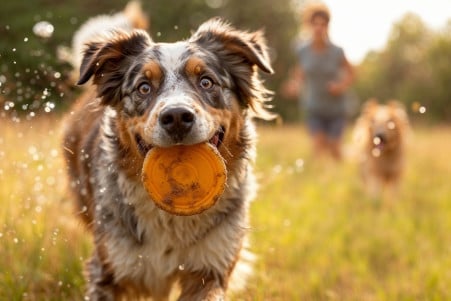Why Do Dogs Stretch So Much? Exploring the Reasons
13 June 2024 • Updated 11 June 2024

There are many reasons why dogs stretch so often, and they have to do with everything from their physical well-being to their comfort and energy levels to their natural instincts. This intro sentence sets up the topic of why dogs stretch so often, and it lets readers know that the article will cover a number of reasons and research findings. Stretching helps dogs relieve muscle tightness and stiffness from resting and sleeping, increases their circulation and oxygen flow, and expends pent-up energy. Dogs may also stretch instinctively after waking up or before physical activity as a way to warm up their bodies.
As for the specific research on this topic, we'll look at evidence from veterinary medicine, dog behavior studies, evolutionary and instinctual theories, and insights from animal professionals and dog trainers. This exploration will help to explain the many reasons behind a dog's stretching behavior and what drives this important yet common part of their daily movement. By learning about the physiological and psychological reasons behind stretching, you can better understand your dog's instincts and requirements.
Why do dogs stretch so much?
Stretching and Senior Dog Health
Stretching is especially important for senior dogs to help them stay mobile, flexible, and healthy as they get older. As Dr. Christina Fuoco from Philadelphia's Whole Animal Gym explains, stretching can help maintain joint health and reduce pain in arthritic joints. Stretching can help senior dogs who are dealing with joint issues, muscle loss, and the reduced range of motion and stiffness that often accompany old age.
Certain stretches, including shoulder extensions, hip flexions, and back stretches, can be especially helpful. For example, as outlined in Sasha Foster's e-book, shoulder extensions can help increase range of motion, while Kim's Urban Hounds suggests hip flexions for dogs with hip problems and back stretches that bend the body into a "C" shape. These stretches can help warm joint fluid, increase blood flow to the joints and muscles, and maintain joint health.
By adding daily stretching sessions to a dog's routine, in addition to supplements like glucosamine, you can help improve joint health and reduce pain and discomfort in older dogs. As Walk in Pets notes, while stretching should be part of a larger exercise regimen to help keep senior dogs as healthy as possible, it's important to work with a vet or a canine physical therapist to create a stretching routine that's safe and effective for a senior dog based on their individual needs and limitations.
What Different Stretches Mean
Dogs stretch in different ways to convey different emotions and messages. For example, the 'greeting stretch' is a sign of love and security, with the dog's front legs extended forward, chest close to the ground, and rear end in the air, according to Bark ATL. On the other hand, the 'play bow' is a sign of excitement and a desire to play, with the dog's front legs extended and elbows touching the ground and the rear end in the air.
The 'tired stretch' is part of a dog's normal daily routine, according to Hanne Grice Pet Training & Behaviour, while the 'prayer position' (front legs and chest on the ground, rear end in the air) can indicate pain or discomfort. Dogs can also be trained to 'bow' as a trick, and An Insider's Guide to Dog Behavior explains that a dog that's nervous may perform a conflicted stretch when offered a treat by a stranger.
Knowing what a dog's stretch means can help you understand their physical and emotional needs. It can also help you better understand what your dog is trying to tell you.
Excessive Stretching: When to Be Concerned
While some stretching is normal and healthy for dogs, excessive or unusual stretching can be a sign of underlying issues. According to Hill's Pet UK, excessive stretching, especially when accompanied by other symptoms like lethargy or vomiting, may indicate conditions like stress, lack of exercise, bloat, or pancreatitis.
Meanwhile, Sit Means Sit Orlando points out that if a dog's stretching patterns or frequency change, especially if they appear to be stretching to alleviate pain, it may be time to take them to the vet. Dog owners should pay attention to their pet's stretching habits and look for any changes, as excessive stretching can be a sign of pain, digestive issues, or respiratory problems.
Regular vet visits can help catch and treat any potential health concerns early on. By keeping an eye out for any changes and making sure to get professional help when necessary, dog owners can make sure their pets are as healthy and happy as possible.
How to Stretch a Dog and Dog Stretches
It's important to stretch dogs correctly to prevent injury and make sure the stretching is effective. As the Coxwell Animal Clinic explains, the most important areas to target when stretching dogs are the shoulders, chest, back, and hips. Stretches should be performed gently and slowly, and the dog's natural range of motion should be respected, meaning that no stretches should be forced.
The Wildest suggests that stretching be added to a dog's regular schedule, such as after a walk or before bed, to help ensure that the dog's flexibility and muscles are maintained. This can involve the shoulder stretch, chest opener, and cookie stretches that are detailed in their article.
Working with a vet or a canine physical therapist can help dog owners make sure they're stretching their pets correctly and that they're creating a stretching routine that will be safe and beneficial. This is especially important for dogs as they age, as well as for athletic dogs and large/giant breed dogs, who may need stretching routines that are tailored to their specific needs, as Animal Wellness Magazine points out.
Why Dogs Should Stretch Regularly
There are many reasons why dogs should stretch regularly, including improved flexibility, better blood flow, and a lower chance of injury. As stated in The Healthy Way To Stretch Your Dog - A Physical Therapy Approach, stretching can help ensure that muscles stay supple and hydrated, which can improve overall movement and reduce the likelihood of a strain or sprain.
For dogs that are especially active or athletic, stretching is important for warming up and cooling down the body, helping to prepare it for exercise and aiding in recovery, according to Expert Tips on Canine Stretching. Stretching can also be a way for dogs and their pet parents to bond, providing a positive and soothing experience.
As outlined in Treatment Techniques: Stretching, stretching can help improve a dog's overall health, well-being, and longevity. By ensuring that stretching is a part of their regular routine, dog owners can help their pets maintain their flexibility, strength, and movement as they age.
Conclusion: Embracing the Stretch
Stretching is a natural and important behavior for dogs, serving various purposes related to their health, comfort, and instincts. Understanding the reasons behind a dog's stretching habits can provide valuable insights into their physical and emotional state, helping owners better meet their needs.
While some stretching is normal and healthy, excessive or unusual stretching may indicate an underlying issue that requires veterinary attention. Incorporating safe and proper stretching techniques into a dog's routine can offer numerous benefits, from increased flexibility and circulation to a stronger bond with their owner.
By embracing the stretch and making it a regular part of their dog's care routine, owners can contribute to their pet's overall well-being and quality of life.


